
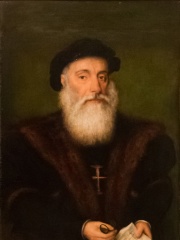
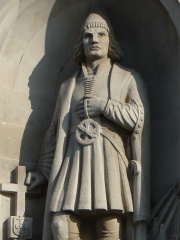

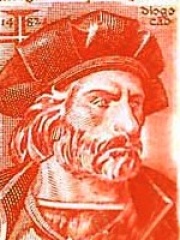


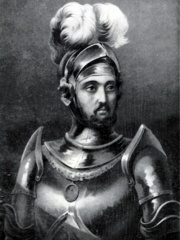
The Most Famous
EXPLORERS from Portugal
This page contains a list of the greatest Portuguese Explorers. The pantheon dataset contains 498 Explorers, 37 of which were born in Portugal. This makes Portugal the birth place of the 4th most number of Explorers behind Spain, and United States.
Top 10
The following people are considered by Pantheon to be the top 10 most legendary Portuguese Explorers of all time. This list of famous Portuguese Explorers is sorted by HPI (Historical Popularity Index), a metric that aggregates information on a biography's online popularity. Visit the rankings page to view the entire list of Portuguese Explorers.

1. Ferdinand Magellan (1480 - 1521)
With an HPI of 92.62, Ferdinand Magellan is the most famous Portuguese Explorer. His biography has been translated into 176 different languages on wikipedia.
Ferdinand Magellan (c. 1480 – 27 April 1521) was a Portuguese explorer best known for planning and leading the 1519–22 Spanish expedition to the East Indies. During this expedition, he discovered the Strait of Magellan, performed the first European crossing of the Pacific Ocean, and made the first known European contact with the Philippines. Magellan himself was killed in battle in the Philippines in 1521, but his crew, commanded by Spanish navigator Juan Sebastián Elcano, completed the return trip to Spain in 1522, achieving the first circumnavigation of Earth in history. Born around 1480 into a family of minor Portuguese nobility, Magellan became a skilled sailor and naval officer in the service of the Portuguese Crown in Asia. However, King Manuel I refused to support Magellan's plan to reach the Moluccas, or Spice Islands, by sailing westwards around the American continent. Magellan then proposed the same plan to King Charles I of Spain, who approved it. In Seville, he married, fathered two children, and organized the expedition. In 1518, for his allegiance to the Hispanic monarchy, Magellan was appointed an admiral of the Spanish fleet and given command of the expedition—the five-ship "Armada of Molucca." He also was made a Commander of the Order of Santiago, one of the highest military ranks of the Spanish Empire. Granted special powers and privileges by the king, he led the Armada from Sanlúcar de Barrameda southwest across the Atlantic Ocean, to the eastern coast of South America, and south to Patagonia. Despite a series of storms and mutinies, the expedition successfully passed through the Strait of Magellan into the Mar del Sur, which Magellan renamed the Mar Pacifico, or Pacific Ocean. The expedition landed at Guam after an arduous crossing of the Pacific, and then reached the Philippines. There, on 27 April 1521, Magellan died in the Battle of Mactan after being shot in the neck with a poison arrow. Under the command of Captain Juan Sebastián Elcano, the expedition finally reached the Spice Islands. The fleet's two remaining ships then parted ways, one attempting, unsuccessfully, to reach New Spain by sailing east across the Pacific. The other ship, commanded by Elcano, sailed west across the Indian Ocean and north along the Atlantic coast of Africa, finally returning to Spain in September 1522. While in the Kingdom of Portugal's service, Magellan had already reached the Malay Archipelago in Southeast Asia on previous voyages traveling east (from 1505 to 1511–1512). By visiting this area again but now traveling west, Magellan achieved a nearly complete personal circumnavigation of the globe for the first time in history.

2. Vasco da Gama (1460 - 1524)
With an HPI of 91.06, Vasco da Gama is the 2nd most famous Portuguese Explorer. His biography has been translated into 167 different languages.
Vasco da Gama ( VAS-koo də GA(H)M-ə, European Portuguese: [ˈvaʃku ðɐ ˈɣɐmɐ]; c. 1460s – 24 December 1524) was a Portuguese mariner, explorer and nobleman. His discovery of the first direct maritime route between Europe and India via the Cape of Good Hope and across the Indian Ocean from Malindi in Kenya to Kozhikode was to open up European exploration of, and commerce with, India, and is considered a landmark event and a turning point in World history. Da Gama's first voyage (1497–1499) was the first to link Europe and Asia using an ocean route that rounded the southern tip of Africa, although he was not the first Portuguese mariner to round the Cape. This route allowed the Portuguese to avoid sailing across the highly disputed Mediterranean Sea and traversing the dangerous Arabian Peninsula. A milestone in Portuguese maritime exploration, this voyage marked the beginning of a sea-based phase of international trade and an age of global imperialism. The Portuguese later established a long-lasting colonial empire along the route from Africa to Asia. The outward and return voyages constituted the longest known ocean voyages ever completed. Sailors had been trying to reach the Indies for decades, with thousands of lives and dozens of vessels lost in shipwrecks and attacks. Da Gama finally accomplished the feat when he landed at Kozhikode on 20 May 1498. Unchallenged access to the Indian spice routes boosted the economy of the Portuguese Empire, which was previously based along North and coastal West Africa. The main spices first obtained from Southeast Asia were pepper and cinnamon, but other commodities new to Europe were soon included in trade. Portugal maintained a commercial monopoly of these commodities for several decades. It was not until a century later that other European powers were able to challenge Portugal's monopoly and naval supremacy in the Cape Route. Da Gama led two of the Portuguese India Armadas, the first and the fourth. The latter was the largest, and departed for India three years after his return from the first. As reward for his accomplishments, da Gama was appointed Governor of India in 1524, with the title of Viceroy, and was ennobled the Count of Vidigueira in 1519. He remains a leading figure in the history of exploration; homages worldwide have celebrated his explorations and accomplishments. The Portuguese national epic poem, Os Lusíadas, was written in his honor by Luís de Camões.

3. Bartolomeu Dias (1450 - 1500)
With an HPI of 84.66, Bartolomeu Dias is the 3rd most famous Portuguese Explorer. His biography has been translated into 77 different languages.
Bartolomeu Dias (c. 1450 – 29 May 1500) was a Portuguese mariner and explorer. In 1488, he became the first European navigator to round the southern tip of Africa and to demonstrate that the most effective southward route for ships is in the open ocean, well to the west of the African coast. His discoveries were later used by Vasco da Gama to establish a sea route between Europe and Asia.

4. Prince Henry the Navigator (1394 - 1460)
With an HPI of 84.33, Prince Henry the Navigator is the 4th most famous Portuguese Explorer. His biography has been translated into 66 different languages.
Prince Henry of Portugal, Duke of Viseu (Portuguese: Infante Dom Henrique; 4 March 1394 – 13 November 1460), better known as Prince Henry the Navigator (Portuguese: Infante Dom Henrique, o Navegador), was a Portuguese prince and a central figure in the early days of the Portuguese Empire and in the 15th-century European maritime exploration. Through his administrative direction, he is regarded as the main initiator of what would be known as the Age of Discovery. Henry was the fourth child of King John I of Portugal, who founded the House of Aviz. After procuring the new caravel ship, Henry was responsible for the early development of Portuguese exploration and maritime trade with other continents through the systematic exploration of Western Africa, the islands of the Atlantic Ocean, and the search for new routes. He encouraged his father to conquer Ceuta (1415), the Muslim port on the North African coast across the Straits of Gibraltar from the Iberian Peninsula. He learned of the opportunity offered by the Saharan trade routes that terminated there, and became fascinated with Africa in general; he was most intrigued by the Christian legend of Prester John and the expansion of Portuguese trade. He is regarded as the patron of Portuguese exploration. He is also considered to be one of the most responsible for developing the slave trade in Western Europe. The prince died on 13 November 1460 in Vila do Bispo, Algarve.

5. Pedro Álvares Cabral (1467 - 1520)
With an HPI of 80.00, Pedro Álvares Cabral is the 5th most famous Portuguese Explorer. His biography has been translated into 79 different languages.
Pedro Álvares Cabral (European Portuguese: [ˈpeðɾu ˈalvɐɾɨʃ kɐˈβɾal]; born Pedro Álvares de Gouveia; c. 1467 or 1468 – c. 1520) was a Portuguese nobleman, military commander, navigator and explorer regarded as the European discoverer of Brazil. He was the first human in history to ever be on four continents, uniting all of them in his famous voyage of 1500, where he also conducted the first substantial exploration of the northeast coast of South America and claimed it for Portugal. While details of Cabral's early life remain unclear, it is known that he came from a minor noble family and received a good education. He was appointed to head an expedition to India in 1500, following Vasco da Gama's newly opened route around Africa. The undertaking had the aim of returning with valuable spices and of establishing trade relations in India—bypassing the monopoly on the spice trade then in the hands of Arab, Turkish and Italian merchants. Although the previous expedition of Vasco da Gama to India, on its sea route, had recorded signs of land west of the southern Atlantic Ocean (in 1497), Cabral led the first known expedition to have touched four continents: Europe, Africa, America, and Asia. His fleet of 13 ships sailed far into the western Atlantic Ocean, perhaps intentionally, and made landfall (April 1500) on what he initially assumed to be a large island. As the new land was within the Portuguese sphere according to the 1494 Treaty of Tordesillas, Cabral claimed it for the Portuguese Crown. He explored the coast, realizing that the large land mass was probably a continent, and dispatched a ship to notify King Manuel I of the new territory. The continent was South America, and the land he had claimed for Portugal later came to be known as Brazil. The fleet reprovisioned and then turned eastward to resume the journey to India. A storm in the southern Atlantic caused the loss of several ships, and the six remaining ships eventually rendezvoused in the Mozambique Channel before proceeding to Calicut in India. Cabral was originally successful in negotiating trading rights, but Arab merchants saw Portugal's venture as a threat to their monopoly and stirred up an attack by both Muslims and Hindus on the Portuguese entrepôt. The Portuguese sustained many casualties and their facilities were destroyed. Cabral took vengeance by looting and burning the Arab fleet and then bombarded the city in retaliation for its ruler having failed to explain the unexpected attack. From Calicut the expedition sailed to the Kingdom of Cochin, another Indian city-state, where Cabral befriended its ruler and loaded his ships with coveted spices before returning to Europe. Despite the loss of human lives and ships, Cabral's voyage was deemed a success upon his return to Portugal. The extraordinary profits resulting from the sale of the spices bolstered the Portuguese Crown's finances and helped lay the foundation of a Portuguese Empire that would stretch from the Americas to the Far East. Cabral was later passed over, possibly as a result of a quarrel with Manuel I, when a new fleet was assembled to establish a more robust presence in India. Having lost favor with the King, he retired to a private life of which few records survive. His accomplishments slipped mostly into obscurity for more than 300 years. Decades after Brazil's independence from Portugal in the 19th century, Cabral's reputation began to be rehabilitated by Emperor Pedro II of Brazil. Historians have long argued whether Cabral was Brazil's discoverer, and whether the discovery was accidental or intentional. The first question has been settled by the observation that the few, cursory encounters by explorers before him were barely noticed at the time and contributed nothing to the future development and history of the land which would become Brazil, the sole Portuguese-speaking nation in the Americas. On the second question, no definite consensus has been formed, and the intentional discovery hypothesis lacks solid proof. Nevertheless, although he was overshadowed by contemporary explorers, historians consider Cabral to be a major figure of the Age of Discovery.

6. Diogo Cão (1440 - 1486)
With an HPI of 71.23, Diogo Cão is the 6th most famous Portuguese Explorer. His biography has been translated into 41 different languages.
Diogo Cão (European Portuguese pronunciation: [diˈoɣu ˈkɐ̃w]; c. 1452 – 1486), also known as Diogo Cam, was a Portuguese mariner and one of the most notable explorers of the fifteenth century. He made two voyages along the west coast of Africa in the 1480s, exploring the Congo River and the coasts of present-day Angola and Namibia.

7. Pêro da Covilhã (1450 - 1530)
With an HPI of 69.90, Pêro da Covilhã is the 7th most famous Portuguese Explorer. His biography has been translated into 30 different languages.
Pêro da Covilhã (Portuguese pronunciation: [ˈpeɾu ðɐ kuviˈʎɐ̃]; c. 1460 – after 1526), sometimes written Pero de Covilhã, was a Portuguese diplomat and explorer. He was a native of Covilhã in Beira. In his early life he had gone to Castile and entered the service of Don Juan de Guzmán, brother of Enrique de Guzmán, 2nd Duke of Medina Sidonia. Later, when war broke out between Castile and Portugal, he returned to his own country, and attached himself, first as a groom, then as a squire, to Afonso V of Portugal and his successor John II of Portugal. In 1487, his overland expedition made its way to India, exploring trade opportunities with the Indians and Arabs, and winding up finally in Ethiopia. His detailed report was eagerly read in Lisbon, as Portugal became the world's best informed center for global geography and trade routes.

8. Diogo Dias (1450 - 1500)
With an HPI of 69.51, Diogo Dias is the 8th most famous Portuguese Explorer. His biography has been translated into 30 different languages.
Diogo Dias, also known as Diogo Gomes, was a 15th-century Portuguese explorer. He was the brother of Bartolomeu Dias and discovered some of the Cape Verde islands together with António Noli.

9. Diego Columbus (1479 - 1527)
With an HPI of 68.73, Diego Columbus is the 9th most famous Portuguese Explorer. His biography has been translated into 25 different languages.
Diego Columbus (Portuguese: Diogo Colombo; Spanish: Diego Colón; Italian: Diego Colombo; 1479/1480 – February 23, 1526) was a navigator and explorer under the kings of Castile and Aragón. He served as the 2nd admiral of the Indies, 2nd viceroy of the Indies and 4th governor of the Indies as a vassal to the kings of Castile and Aragón. He was the eldest son of Christopher Columbus and his wife Filipa Moniz Perestrelo. He was born in Portugal, either in Porto Santo in 1479 or 1480, or in Lisbon in 1474. He spent most of his adult life trying to regain the titles and privileges granted to his father for his explorations and then denied in 1500. He was greatly aided in this goal by his marriage to María de Toledo y Rojas, niece of the 2nd Duke of Alba, who was the cousin of King Ferdinand.
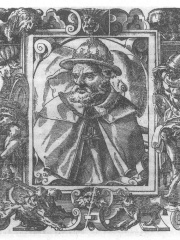
10. Tristão da Cunha (1460 - 1540)
With an HPI of 68.52, Tristão da Cunha is the 10th most famous Portuguese Explorer. His biography has been translated into 33 different languages.
Tristão da Cunha (sometimes misspelled Tristão d'Acunha; Portuguese pronunciation: [tɾiʃˈtɐ̃w dɐ ˈkuɲɐ]; c. 1460 – c. 1540) was a Portuguese explorer and naval commander. In 1514, he served as ambassador from King Manuel I of Portugal to Pope Leo X, leading a luxurious embassy presenting in Rome the new conquests of Portugal. He later became a member of the Portuguese privy council.
People
Pantheon has 37 people classified as Portuguese explorers born between 1390 and 1846. Of these 37, none of them are still alive today. The most famous deceased Portuguese explorers include Ferdinand Magellan, Vasco da Gama, and Bartolomeu Dias.
Deceased Portuguese Explorers
Go to all RankingsFerdinand Magellan
1480 - 1521
HPI: 92.62
Vasco da Gama
1460 - 1524
HPI: 91.06
Bartolomeu Dias
1450 - 1500
HPI: 84.66
Prince Henry the Navigator
1394 - 1460
HPI: 84.33
Pedro Álvares Cabral
1467 - 1520
HPI: 80.00
Diogo Cão
1440 - 1486
HPI: 71.23
Pêro da Covilhã
1450 - 1530
HPI: 69.90
Diogo Dias
1450 - 1500
HPI: 69.51
Diego Columbus
1479 - 1527
HPI: 68.73
Tristão da Cunha
1460 - 1540
HPI: 68.52
Pedro Fernandes de Queirós
1565 - 1614
HPI: 67.67
João Gonçalves Zarco
1390 - 1471
HPI: 67.42



